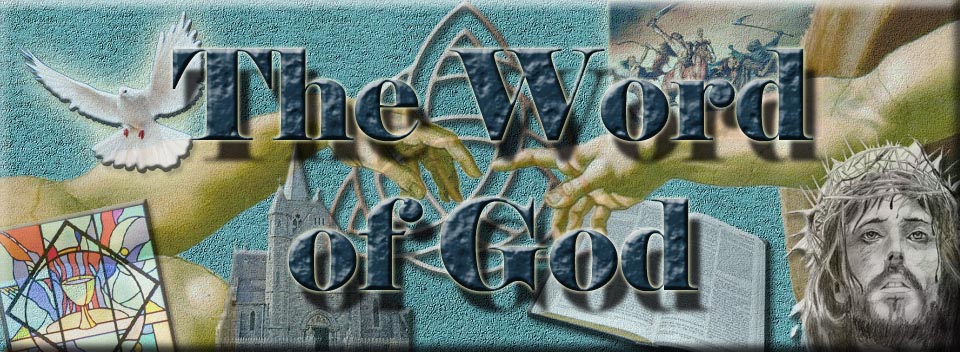
Major Divisions of the Bible
Illustrated Dictionary of the Bible
|
THE BIBLE
- The sacred Book, or collection of books, accepted by the Christian
church as uniquely inspired by GOD, and thus
authoritative, providing guidelines for belief and behavior.
Major Divisions: The Bible contains two major sections known as the Old Testament and the New Testament. The books of the Old Testament were written over a period of about 1,000 years in the Hebrew language, except for a few selected passages, which were written in Aramaic. The Old Testament tells of the preparation that was made for Christ's coming. The New Testament was written over a period of about 100 years. The original language in which it was written was Greek. This portion of the Bible tells of Christ's coming, His life and ministry, and the growth of the early church. The English word testament normally refers to a person's will, the document which bequeaths property to those who will inherit it after the owner's death. But the meaning of testament from both the Hebrew and the Greek languages is "settlement", "treaty", or "covenant". Of these three English words, "COVENANT" best captures the meaning of the word testament. Thus, the two collections that make up the Bible can best be described as the books of the old covenant and the books of the new covenant. The old covenant is the covenant sealed at Mt. Sinai in the days of Moses. By this covenant, the living and true GOD, who had delivered the Israelites from slavery in Egypt, promised to bless them as His special people. They were also to worship Him alone as their GOD and to accept His law as their rule for life (Exod. 19:3-6; 24:3-8). The new covenant was announced by Jesus as he spoke to His disciples in the upper room in Jerusalem the night before His death. When He gave them a cup of wine to drink, Jesus declared that this symbolized "the new covenant in My blood" (Luke 22:20; I Cor. 11:25). Between the times of Moses and Jesus, the prophet Jeremiah foresaw a day when GOD would make a new covenant with His people. Under this new covenant, GOD would inscribe His laws on the hearts of people rather than on tablets of stone (Jer. 31:31-34). In the New Testament, this new covenant of which Jeremiah spoke is identified with the covenant inaugurated by Jesus (Heb. 8:6-13). While these two covenants, the old and the new, launched great spiritual movements, Christians believe these movements are actually two phases of one great act through which GOD has revealed His will to His people and called for their positive response. The second covenant is the fulfillment of what was promised in the first. In the form in which it has been handed down among the Jewish people, the Old Testament, or Hebrew Bible, contains three divisions: the Law, the Prophets, and the Writings. The Law consists of Genesis, Exodus, Leviticus, Numbers, and Deuteronomy; this section of the Old Testament is also known as the PENTATEUCH. The Prophets fall into two subdivisions: the former prophets (Joshua, Judges, First and Second Samuel, and First and Second Kings) and the latter prophets (Isaiah, Jeremiah, Ezekiel, and the Book of the Twelve Prophets - Hosea through Malachi). The rest of the books are gathered together in the Writings: Psalms, Proverbs, Job, Song of Solomon, Ruth, Lamentations, Ecclesiastes, Esther, Daniel, Ezra-Nehemiah (counted as one book), and First and Second Chronicles. The arrangement of the Old Testament with which readers today are most familiar has been inherited from the pre-Christian Greek translation of the Old Testament (the SEPTUAGINT) - an arrangement which was also followed by the later Latin Bible (the Vulgate). This arraangement has four divisions: the Pentateuch, the historical books, poetry, and prophecy. The New Testament opens with five narrative books - the four gospels and the Acts of the Apostles. The gospels deal with the ministry, death, and resurrection of Jesus. The Book of Acts continues the story of the development of the early church across the next 30 years. Acts serves as a sequel to the gospels in general; originally it was written as a sequel to the Gospel of Luke in particular. Twenty-one letters, or epistles, follow the historical narratives. Thirteen of these letters bear the name of the apostle Paul as writer, while the remaining eight are the work of other apostles or of authors associated with apostles. The last book in the New Testament, the Revelation of John, portrays through visions and symbolic language the accomplishment of GOD's purpose in the world and the ultimate triumph of Christ. Taken from: the "Illustrated Dictionary of the Bible" by Herbert Lockyer, Sr., Editor with F. F. Bruce and R. K. Harrison, published by Thomas Nelson Publishers in 1986. |
-
Site Navigation
 Home
Home What's New
What's New Bible
Bible Photos
Photos Hiking
Hiking E-Books
E-Books Genealogy
Genealogy Profile
Free Plug-ins You May Need
Profile
Free Plug-ins You May Need
 Get Java
Get Java.png) Get Flash
Get Flash Get 7-Zip
Get 7-Zip Get Acrobat Reader
Get Acrobat Reader Get TheWORD
Get TheWORD